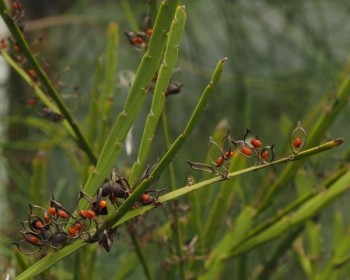This article was published in The Fringe, July 2015
Native Broom
In New Zealand broom trees fall into two categories: the non-native, very weedy and costly imports from abroad and the increasingly rare and strangely beautiful indigenous Carmichaelia species, all of which are endemic, that is, growing nowhere else in the world.
There is just one non-New Zealand Carmichaelia species, being an endemic on Lord Howe Island, Carmichaelia exsul (exsul means exile).
The weed species are members of the genera Cytisus and Genista, native to Western Europe, and accustomed to surviving fire by regrowing from either the stout subterranean root system or the seeds which benefit from the heat of the fire to germinate. Weed control authorities throughout the country spend a lot on eradicating these weed species particularly along river banks where they can confine the flow of waters that traditionally spread out forming braided rivers.
The native species have long been recognised as oddities, being predominantly leafless, and relying on the chlorophyll in their stems which are often green and flattened.
They range throughout most habitats with species found in both wet and dry conditions, from the far north to Stewart Island, and from coastal to alpine sites including the harsh moraine conditions left by retreating glaciers. The native brooms can tolerate these diverse habitats because they generate their own nitrogen in root nodules. Some are dwarf cushion-like plants, some more like scrambling vines, and others upright trees to more than 10 metres. Carmichaelia stevensonii is perhaps the largest and most beautiful, with weeping foliage and cascading bunches of pink flowers, but it is difficult to grow. Others mostly have small purple flowers followed by curious seed pods that look a bit like diminutive pea pods, but often the sides fall off leaving an oval rib from which the seeds hang awaiting wind or birds to disperse them.

There have been up to 68 names applied to different forms of the native brooms but only about 40 of them were generally recognised by botanists. Then in 1995 a revision of the family reduced the number of species from about 40 to just 17 species. The common broom in the Waitakere Ranges, Carmichaelia aligera, was combined with another 12 species into the Carmichaelia australis swarm. I particularly liked our local form as it seems to have the widest, most flattened branches (known as cladodes), apart from a singularly different species from the Bay of Plenty, Carmichaelia williamsii.
So why was the revision so drastic reducing at least 40 discernible species to 17 species several of which contain widely disparate forms? Taking Carmichaelia australis as the example, the published description has a broad sweep of characters to include plants from a wide range of habitats around the country. Many of the species are defined by the flowers, others by the seed pods, but to the casual observer they can be distinguished by their stems, their colour, or their growth habit. What it boils down to is one man's judgement that it is too soon to be swayed by minor differences as the swarm of different forms are evolving into new species. Therefore we should just wait!
Well, sorry, we need clarity now, and it is not good enough to say Carmichaelia australis grows throughout most of New Zealand but for Southland and Otago. Every habitat type and regional form is different and we need to know what the differences are so we can use the correct type and form in revegetation plantings. With 40, or even 68 defined forms, we can be more confident that we recognise and use them correctly. Even if botanists do not recognise these differences, nurserymen do, and it is important that we are given the appropriate names to advise the gardening public of what to plant where.

